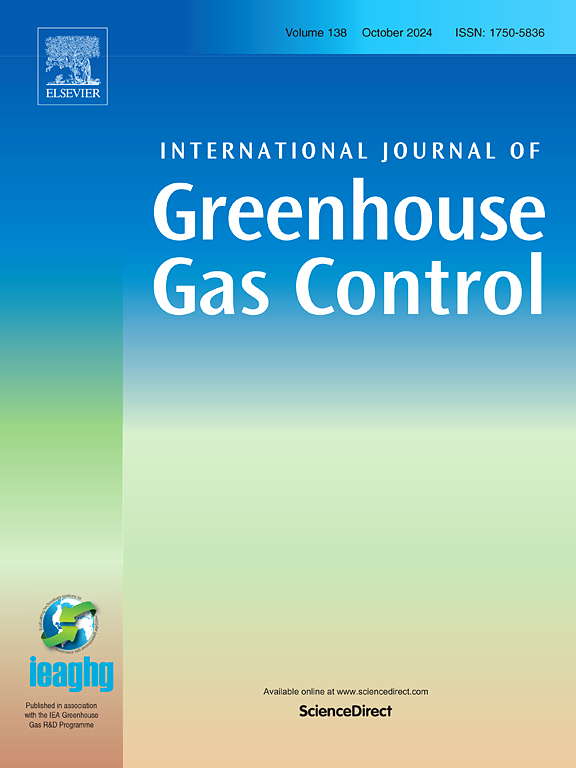On the design of ultra-sparse seismic surveys for monitoring subsurface CO2 storage sites using full waveform inversion
IF 5.2
3区 工程技术
Q2 ENERGY & FUELS
International Journal of Greenhouse Gas Control
Pub Date : 2025-07-16
DOI:10.1016/j.ijggc.2025.104433
引用次数: 0
Abstract
Monitoring the dynamics of CO in subsurface reservoirs allows the conformance of carbon capture and storage (CCS) projects to be assessed. Full waveform inversion (FWI) of data from dense, time-lapse seismic surveys can provide high resolution images of dynamic changes. However, FWI solutions remain highly non-unique, so uncertainties must be accounted for to ensure that conformance verification is robust. Time-lapse seismic FWI is therefore expensive because, first, dense surveys are costly to acquire, and second, quantifying realistic uncertainties requires extreme computational power and memory. We first introduce a significantly less costly method to quantify Bayesian uncertainties in the maximum a posteriori (MAP – most likely) solutions of time-lapse seismic velocity changes. The method embodies strong prior information from the baseline survey to inform inversions of monitoring surveys. In contrast to comparable methods, these uncertainty estimates are shown to be of a reasonable magnitude to inform subsequent decision-making. This method also allows the quality of prospective survey designs to be assessed in terms of expected confidence in time-lapse imaging results, at reasonable computational cost. We therefore perform a time-lapse seismic survey design study to assess the quality of more economically attractive surveys. We demonstrate for the first time that even if extremely sparse acquisition geometries are deployed, potentially even involving only a single seismic source and recordings on a single fibre-optic cable, reasonable images of subsurface time-lapse velocity changes are produced, and uncertainties remain sufficiently low to enable robust decision-making.
基于全波形反演的超稀疏地震勘探方法设计
监测地下储层中二氧化碳的动态可以评估碳捕集与封存(CCS)项目的一致性。密集时移地震勘探数据的全波形反演(FWI)可以提供高分辨率的动态变化图像。然而,FWI解决方案仍然是非唯一的,因此必须考虑不确定性,以确保一致性验证的可靠性。因此,延时地震FWI价格昂贵,因为首先,密集调查的获取成本很高,其次,量化现实的不确定性需要极高的计算能力和内存。我们首先介绍了一种成本明显较低的方法来量化时移地震速度变化的最大后验(MAP - most likely)解中的贝叶斯不确定性。该方法体现了来自基线调查的强先验信息,为监测调查的反演提供了信息。与可比方法相比,这些不确定性估计具有合理的幅度,可为后续决策提供信息。该方法还允许在合理的计算成本下,根据延时成像结果的预期置信度来评估前瞻性调查设计的质量。因此,我们进行了一项延时地震调查设计研究,以评估更具经济吸引力的调查的质量。我们首次证明,即使部署了极其稀疏的采集几何形状,甚至可能只涉及单个地震源和单个光纤电缆的记录,也可以产生合理的地下时距速度变化图像,并且不确定性仍然足够低,可以实现稳健的决策。
本文章由计算机程序翻译,如有差异,请以英文原文为准。
求助全文
约1分钟内获得全文
求助全文
来源期刊
CiteScore
9.20
自引率
10.30%
发文量
199
审稿时长
4.8 months
期刊介绍:
The International Journal of Greenhouse Gas Control is a peer reviewed journal focusing on scientific and engineering developments in greenhouse gas control through capture and storage at large stationary emitters in the power sector and in other major resource, manufacturing and production industries. The Journal covers all greenhouse gas emissions within the power and industrial sectors, and comprises both technical and non-technical related literature in one volume. Original research, review and comments papers are included.

 求助内容:
求助内容: 应助结果提醒方式:
应助结果提醒方式:


